Food is one of our most basic needs. We cannot live without it. Food gives us the energy for everything we do—walking, talking, working, playing, reading, and even thinking and breathing. In addition, food supplies the substances we require to grow and to repair and maintain our bodies.
All living things need food, even plants. Green plants, algae, and certain other living things use the energy of sunlight to make food, using carbon dioxide—a gas in the air—and water and other substances from the soil. Many other living things depend on the food made by these organisms.
Food does more than keep us strong and healthy. It also adds pleasure to life. We enjoy the tastes, aromas, colors, and textures of foods. We celebrate special occasions with favorite meals and feasts.
There are a remarkable variety of foods. Plants provide foods such as fruits, vegetables, beans, nuts, and spices. Flour, sugar, and many kinds of oil also come from plants. Animals provide meat, eggs, and milk. These basic foods may require little or no preparation before cooking or eating. Or they may be transformed through processing. For example, corn can serve as the basis of tortillas, corn bread, cooking oil, soda, candy, chips, and a variety of other processed foods.
In less developed countries, many families produce their food themselves. In the United States, Canada, and other developed countries, however, most people rely on the food industry for their food. The food industry includes farmers, food-processing companies, researchers, shipping companies, grocery stores, and restaurants. The growth of the food industry has greatly increased the amount and variety of foods available in developed countries.
The foods that people eat vary widely around the world. Some regions have distinctive cuisines (cooking styles) based on local ingredients and traditional cooking methods. But many cuisines have changed greatly over time. And as cultures have become more interconnected, local food cultures show fewer differences. As living standards have improved around the world, more people have adopted diets based on meat, refined flours, and other processed foods.
Supplying enough food for the world’s growing population is a great challenge. Millions of people around the world go hungry and some die of starvation. Food shortages and famine can result from crop failures, natural disasters, overpopulation, and wars. For detailed information about food supply problems, see the articles Food supply and Famine. For information on how food is prepared and eaten, see Cooking and Taste.
Sources of food
Plants supply most of the food people eat. In many African, Asian, and Latin American countries, people depend on plants for more than two-thirds of their food. Even in places where people eat much more meat— such as Australia, Europe, North America, and parts of South America—plants still make up over half the diet. In addition, the cows, pigs, chickens, and other livestock eaten in these areas are raised on plant foods.
Consumers commonly buy some foods in their natural forms. Such foods include eggs, fruits, and vegetables. But even many basic foods—such as meat, milk, and flour—are processed before they reach the grocery store. All canned, dried, frozen, and pickled foods have been processed.
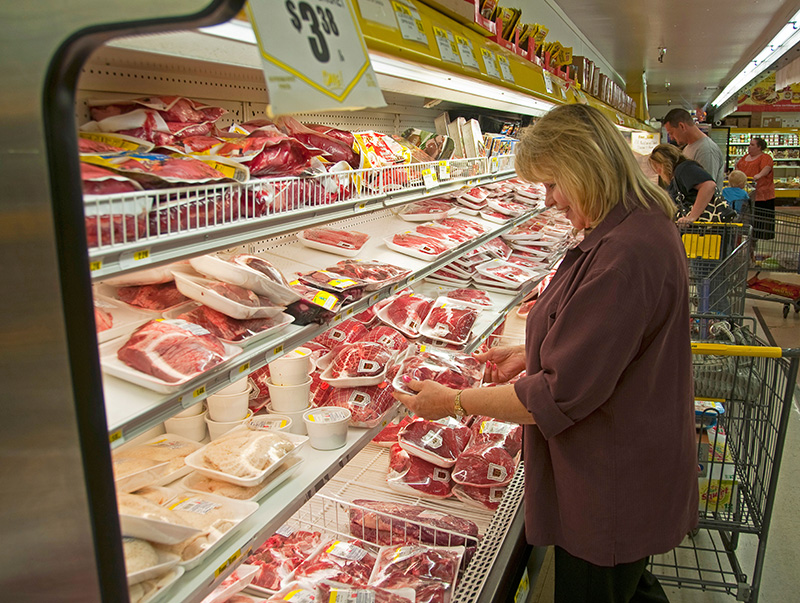
Most grocery stores also stock many highly processed foods, including frozen dinners, potato chips, crackers, breakfast cereals, ice cream, and other convenience foods. But highly processed foods often have large amounts of salt, sugar, and fat. They can be harmful if people eat too much of them.
Food from plants.
Many important foods are obtained from plants. The most important are (1) grains, (2) fruits and vegetables, and (3) pulses.
Grains,
also called cereals, are the seeds of plants such as barley, corn, millet, oats, rice, rye, sorghum, and wheat. The human diet has been based on grains for thousands of years. Such grain products as rice or bread are the staple (most important) foods of most cultures. Millers grind much of the world’s grain into different kinds of flour, including corn, oat, and rye flour. In the United States, wheat is the most common type of flour. It is used in most breads, pastries, and pasta.
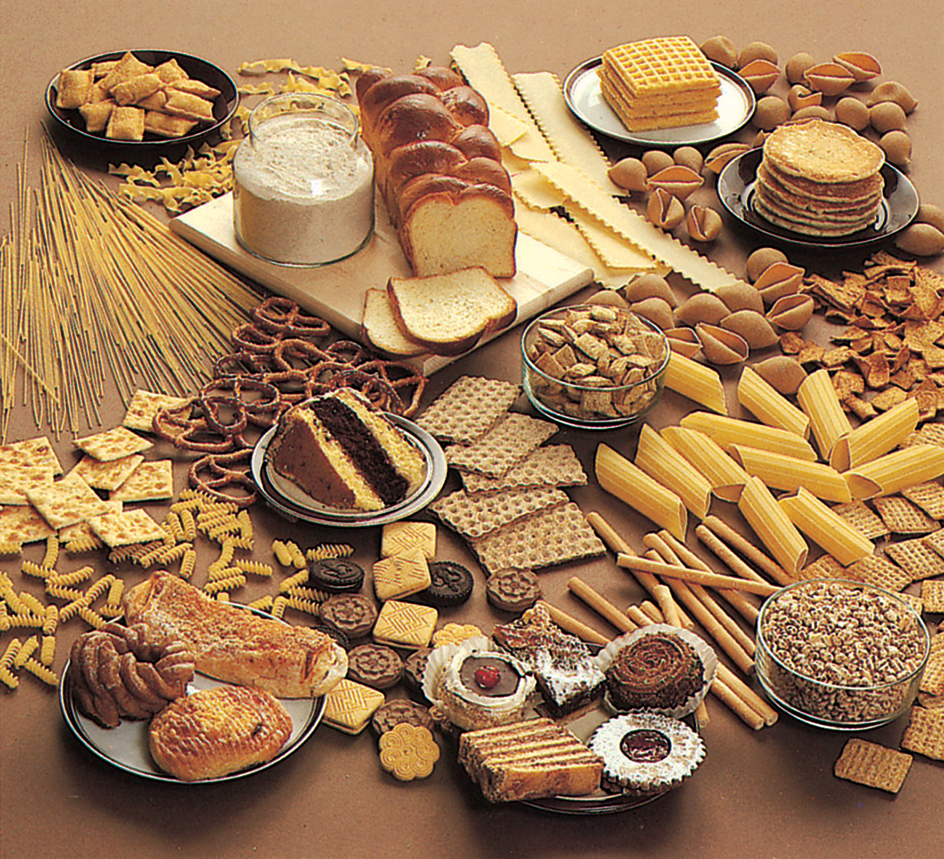
Fruits and vegetables
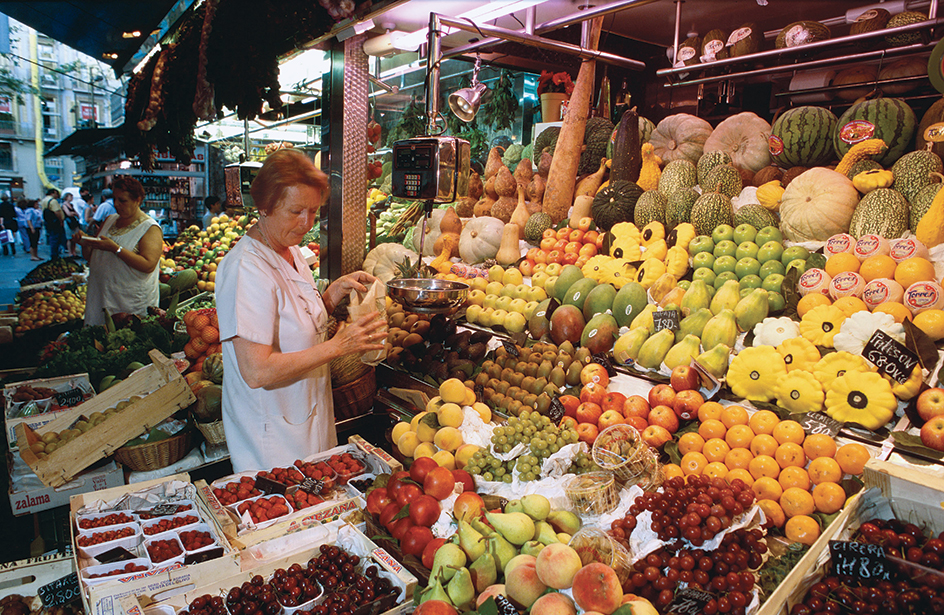
add a variety of colors, flavors, and textures to the diet. They also add nutrition. Popular fruits include apples, bananas, dates, grapes, mangoes, melons, oranges, peaches, pears, plantains, plums, and tomatoes. Favorite vegetables include broccoli, cabbage, carrots, celery, lettuce, and onions. In some countries, such starchy vegetables as potatoes and cassava are staples instead of grains. People can pound such vegetables to produce flour.
Pulses
include beans, lentils, and peas. Unlike most other plants, pulses contain high amounts of protein, an important nutrient.
Other foods from plants
include nuts, herbs, and spices. Coffee, cocoa, tea, and many other drinks are made from plants. Food manufacturers also use plant materials to make cooking oils, sugar, and syrups.
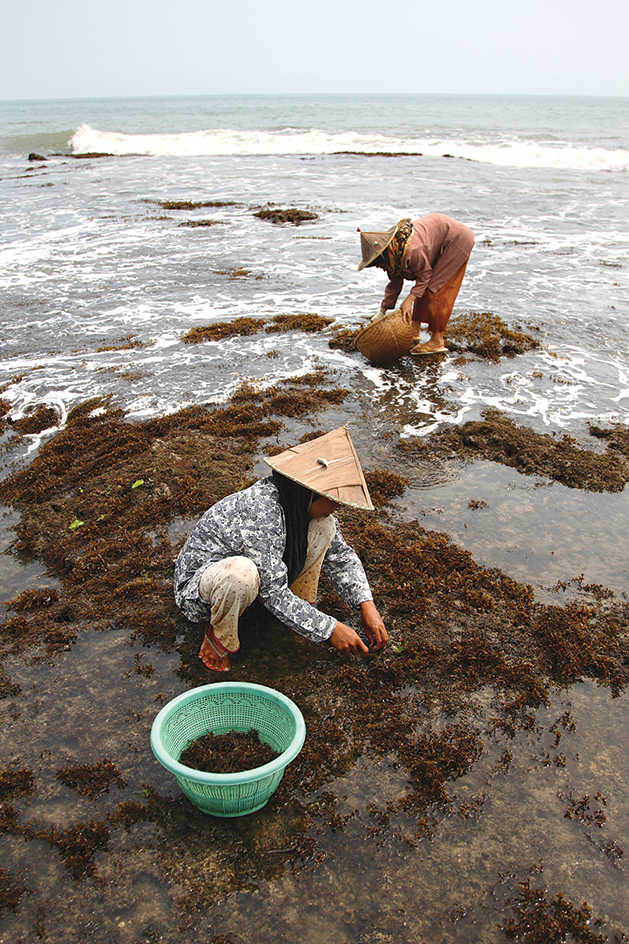
Food from animals
includes (1) meat, (2) eggs, and (3) dairy products. Animal products take much more energy to make because animals eat much more food than they produce. As a result, animal products generally cost more than do foods from plants. People in developed countries eat more animal products than people in less developed ones.
Meat
consists of the muscle, fat, organs, and other parts of an animal’s body. Much meat comes from livestock animals raised by farmers. People also hunt wild game animals for their meat and consume fish raised on farms or caught in the wild.

Some people use the word meat to refer to the flesh of mammals only. Such meats include beef, from cattle, and pork, from hogs. Poultry comes from chickens, turkeys, and other birds. Seafood includes fish and such shellfish as shrimp and mussels. Animal organs, such as livers, tongues, and hearts, are known as offal.
Meat is often sold as cuts, such as chops and steaks. Meat is usually cooked before it is eaten. Heating develops the flavor and destroys microbes that may cause illness. Such meats as ham and corned beef are cured (preserved) before being sold. Meats also are processed into such products as sausages and cold cuts.
Eggs.

Farmers raise poultry, especially chickens, for their eggs as well as for their flesh. Chicken eggs are popular for breakfast or in the main dishes of other meals. They are also used in ice cream and many kinds of baked goods. A delicacy called caviar comes from the salted eggs of a group of fish called sturgeon. In some countries, people enjoy the eggs of such birds as emus, gulls, ducks, or penguins. Some people also eat the eggs of alligators, crocodiles, or other reptiles.
Dairy products
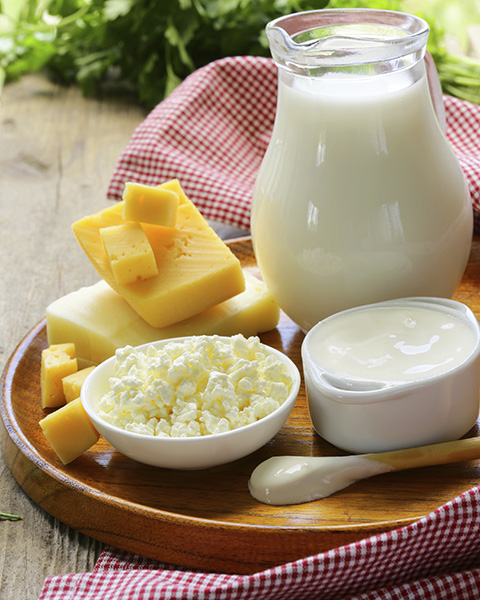
are important foods in many cultures. Cows provide most of the milk used in the United States and Canada. But such animals as camels, goats, reindeer, and sheep supply milk in other parts of the world. Milk and milk products reach the market in many forms. People can buy skim milk, low-fat milk, whole milk, and condensed, dried, or evaporated milk. Other dairy products include butter, cheese, cream, pudding, ice cream, sour cream, buttermilk, and yogurt.
Food from fungi
includes mushrooms and yeast. Mushrooms are often cooked like vegetables, but they have a savory flavor similar to meat. Yeast is a single-celled fungus that is used to make such foods as bread and pastries.
Nutrition
Food supplies the nutrients (nourishing substances) that the body needs. The main kinds of nutrients are carbohydrates (sugars and starches), fats, proteins, vitamins, and minerals. Each kind of nutrient plays an important role in keeping the body healthy. Many foods are nourishing. But no single food supplies all the nutrients we need. To stay healthy, people need to eat a variety of different foods—especially fruits, vegetables, and whole grains.
In addition to nutrients, food supplies water and fiber. All living things need water to live. Fiber adds bulk to food and keeps waste products moving through the intestines and out of the body.
A shortage of certain vitamins can cause disease. For example, too little vitamin C causes scurvy, which is marked by sore, bleeding gums, easy bruising, and broken capillaries (small blood vessels). Too little vitamin D can lead to rickets, a bone disease.
People who do not get enough food are undernourished. A person whose diet seriously lacks any nutrient is malnourished. Some malnourished people eat plenty of food. For example, people could eat rice or hamburgers for every meal and never go hungry. But they would still be malnourished, because such foods do not provide all the vitamins and minerals necessary for good health.
People who eat more food than their body needs can become overweight or obese (having excessive body fat). In the United States, more than half of adults and roughly a third of all children are overweight or obese. People who are obese are more likely to have various life-threatening ailments such as heart disease, diabetes, and some forms of cancer. Eating large amounts of sugar and fat can contribute to obesity.
A moderate, well-balanced diet helps ensure good health. For detailed information about the foods that contribute to a healthful diet, see Nutrition.
Variations in diet
The kinds of food that people eat vary from one country to another and even within countries. In some countries , for example, people may eat meat every day. In other countries, meat is served only on special occasions.
People who are vegetarians eat no meat at all. Vegans avoid all products that come from animals, including eggs, dairy, and gelatin. Some people choose to become vegetarians or vegans because they object to the idea of eating animals or because they want to reduce their impact on the environment. Others follow vegan or vegetarian religious or cultural traditions. Some people eat a largely vegetarian diet because they cannot afford to buy meat.
Foods that appeal to certain people are unappetizing to others. In different parts of the world, for example, people enjoy many foods not often eaten in the United States. Such foods include ants, grasshoppers, snails, dogs, and cats. Likewise, common American foods, such as peanut butter or cheese, may seem strange or unappetizing to people in other countries. The foods that are considered “normal” or “strange” also change over time. For example, Americans in the 1800’s commonly ate turtles and pigeons. To many Americans today, those foods seem strange. On the other hand, eating raw fish in sushi has become more common in the United States and other areas.
People prepare foods differently around the world. In many cases, the methods of food preparation depend on the available fuel resources and cooking equipment. In less developed countries, for example, many people cook foods using a basic coal or wood cook stove or over an open fire. In developed countries, many people use a modern gas or electric stove or a microwave oven. Certain people like to eat most of their foods raw. Some people add spices to their dishes. Others prefer little seasoning. Some people eat only natural, unprocessed, foods. Others eat foods that have been highly processed.
Diets differ for a number of reasons, including (1) geographic differences, (2) economic differences, (3) religious differences, and (4) differing customs. But differences in diet around the world are not as great as they once were. Globalization, tourism, and modern communication systems have led to an exchange of foods, recipes, and eating habits among people throughout the world.
Geographic differences.
The location, climate, and physical features of a region influence what people in that region eat. A region’s terrain and soil determine which crops can grow there. For example, corn grows best on level, open fields with rich, well-drained soil. Rice grows best in fields covered with shallow water.
Traditionally, people who lived on islands or along seacoasts depended heavily on seafood. People who lived far from the sea often relied on livestock or grains. People in tropical areas could grow a variety of fruits and vegetables all year long. On the other hand, people in colder regions with short growing seasons had to depend on such crops as grains or potatoes that could be stored during long winters.
Geography and climate still influence what people eat. But the importance of these factors has declined. This fact is especially true in developed countries. Faster transportation and modern methods of food preservation enable many people to eat foods produced far away. For example, people in many countries enjoy bananas from Ecuador, almonds from California, olives and oranges from Spain, dairy products from New Zealand, and sardines from Morocco.
In addition, many farmers have learned how to grow crops in unfavorable areas. Where land is hilly, for example, they might carve strips of land out of the hillsides. In dry areas, farmers might use irrigation. In areas with cold winters, they might grow some fruits and vegetables in greenhouses during the winter.
Economic differences.
The variety and amount of food that people have to eat depends largely on their country’s economy. But even in the richest countries, some people cannot afford a good diet. Others simply choose to eat foods that are not nourishing. And some people in the poorest countries do have a well-balanced diet.
Most developed countries can either produce all the food their people need or import the necessary supplies. Farmers in developed countries use modern machinery and scientific methods to maximize their production. Developed countries also have modern facilities to process, transport, and store food.
In highly developed countries, people are more likely to have a diet rich in animal products as well as grains, vegetables, and fruits. Because people in developed countries can usually afford more food, they sometimes eat too much of it—especially highly processed foods. As a result, diseases related to obesity are more common in developed countries.
Less developed countries are often not able to produce or import enough food for all their people. Many farmers are too poor to buy fertilizers, machinery, and other materials that would increase their output. Less developed countries also lack modern facilities for processing, transporting, and storing food. As a result, many people in less developed countries suffer from an inadequate diet. They are too poor to buy all the food they need or a wide variety of foods. They rely on grains and other cheap staple crops for most of their nutrients. Millions of poor small farmers depend on the foods they can raise themselves on small plots of land.
Religious differences.
Many religions have rules that deal with food. Some religions do not permit their members to eat certain foods. Many Hindus do not eat beef because they consider cows to be sacred. Some groups of Hindus do not eat any kind of meat. Observant Jews keep kosher. They do not eat pork, shellfish, and certain other foods and must follow strict dietary laws regarding the storage, preparation, and serving of food. Observant Muslims do not eat pork or drink alcohol. They limit their diet to halal foods that are prepared in accordance with Islam’s dietary laws.
Some religions set aside certain days for fasting and feasting. For example, Muslims are not supposed to eat or drink from dawn to sunset during Ramadan, the ninth month of the Islamic year. They celebrate Ramadan’s end with a feast. Some Christians observe the season of Lent by giving up meat or other foods.
Customs
influence what people eat and how they prepare, serve, and eat foods. In some cultures, the way food is served is almost as important as how it is prepared. For example, in France and Japan, chefs have traditionally arranged food with great care, making each dish look beautiful. In Sweden, smörgåsbord is a popular tradition. Smörgåsbord consists of a long table set with such foods as breads, cheeses, fish, salads, and hot and cold meats.

Customs also can affect the times when people eat. In most Western cultures, for example, people commonly eat three meals a day. These meals are breakfast, lunch, and dinner. The English sometimes add a light, extra meal, called tea, late in the afternoon. Spanish people commonly eat dinner at 9:00 p.m. or later.
In some societies, people eat from a common serving dish and use few utensils. Some people scoop up their food with bread, such as the tangy, spongy injera flatbread of Ethiopian cuisine. In East Asia, people usually use chopsticks. In Western cultures, most people eat from individual plates and use knives, forks, and spoons. Or they eat food from paper wrappers or other disposable containers.
Cuisines around the world
Many countries and regions have traditional dishes based on local ingredients and unique cooking techniques. Even small variations in common ingredients, seasonings, and cooking methods can give dishes a special regional or national flavor. In the United States, for example, people in Texas serve chili con carne—a spicy meat stew—with beans on the side, not cooked in the chili. In the Midwest, on the other hand, people often cook chili with beans. In Cincinnati, Ohio, people serve cinnamon-spiced chili over spaghetti.
Certain basic ingredients and techniques have influenced widespread cuisines. For example, variations on the Spanish sofrito—chopped and sautéed onions, garlic, and other vegetables—form an important element in dishes from the Caribbean islands, Mexico, and other parts of Latin America colonized by the Spanish. The similar French mirepoix, a mixture of sautéed onions, carrots, and celery, forms a flavor base for many soups and stews in Europe and the United States. Soy sauce originated in China centuries ago and has since become a central ingredient in many Asian cuisines. Local cuisines thus often reflect a deep history of interactions among many different cultures.
Europe.
French chefs are known for their elaborate dishes, rich sauces, and buttery pastries. Perhaps the most famous traditional English dish is roast beef and Yorkshire pudding, a savory batter pudding baked in beef juices. But many English people enjoy fragrant stews called curries from India, which was once a British colony. Italy is known for its pasta and for sauces made with tomatoes, garlic, and olive oil. Sausages, potatoes, cabbage, and beer are common in the German diet. Scandinavians enjoy herring and other fish as well as excellent cheeses, meats, and many kinds of breads.
The Americas.
Many foods in Canada and the United States reflect the cuisines of immigrants who settled in these countries. For example, hamburgers and hot dogs are based on German “Hamburg steaks” and frankfurter sausages. Americans enjoy a number of regional styles of barbecue, in which meat is slowly cooked over a smoky fire. Many American foods—both traditional and highly processed—are made with corn, a staple crop first grown by the native Americans in Mexico.
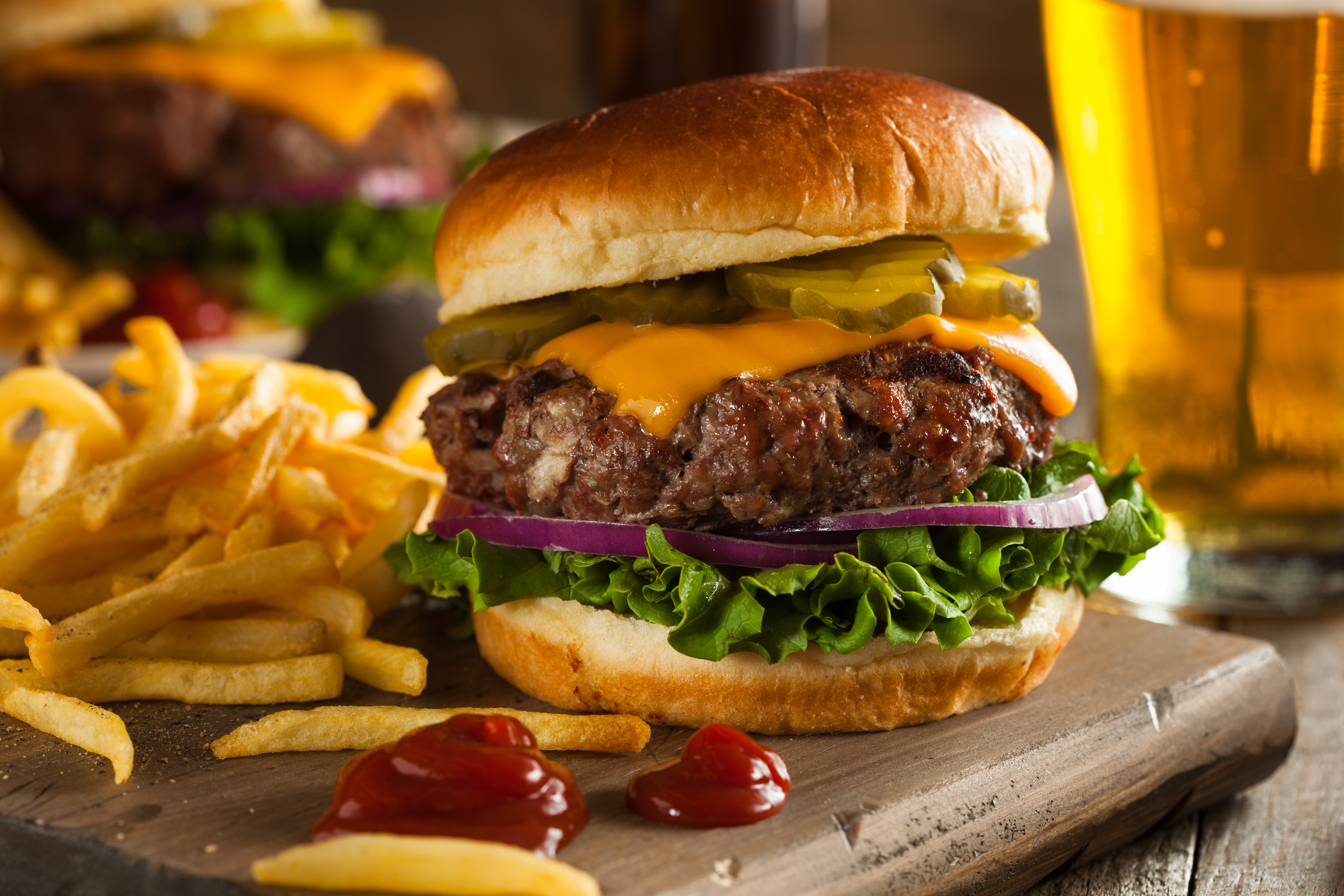
Flatbread tortillas made from corn or wheat flour are common in Mexico and Central America. Molé is a rich Mexican chili pepper-based sauce that can include a variety of ingredients, including ground nuts and chocolate. In such countries as Venezuela and Colombia, people eat thick corn cakes called arepas. A Latin American dish called ceviche is made from raw seafood that is “cooked” in the acidic juice from limes and other citrus fruits. Caribbean cooking features influences from many other cuisines, reflecting the diverse geographic origins of its peoples. Such ingredients as beans, cassava, coconut, bananalike plantains, peppers, rice, and tomatoes are commonly used.
Africa and the Middle East.
Pita bread, a flatbread made from wheat, is common in the Middle East and North Africa. Other common ingredients used in Middle Eastern cooking include chickpeas, lentils, tahini (sesame paste), lamb, olive oil, and mint. In Moroccan cuisine, stews called tagines are cooked in earthen pots and often flavored with pickled lemons.
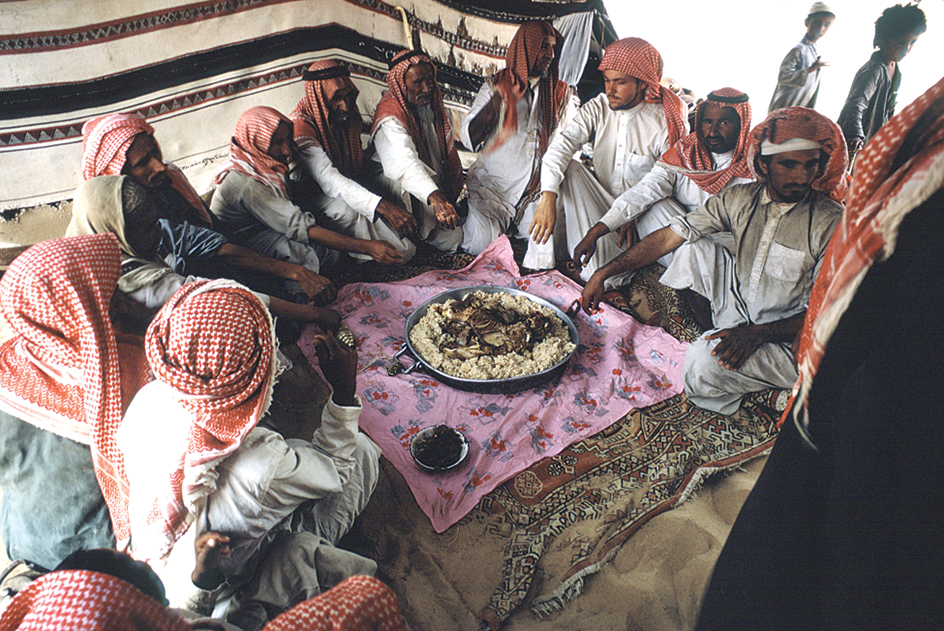
In sub-Saharan Africa—the part of Africa south of the Sahara desert—corn, rice, cassava, plantains, yams, and other starchy foods are common staples. Such foods are often made into a thick porridge or doughlike dish. In West and Central Africa, this dish is generally known as fufu. In East Africa, a similar dish called ugali is made from corn.
Asia and the Pacific.
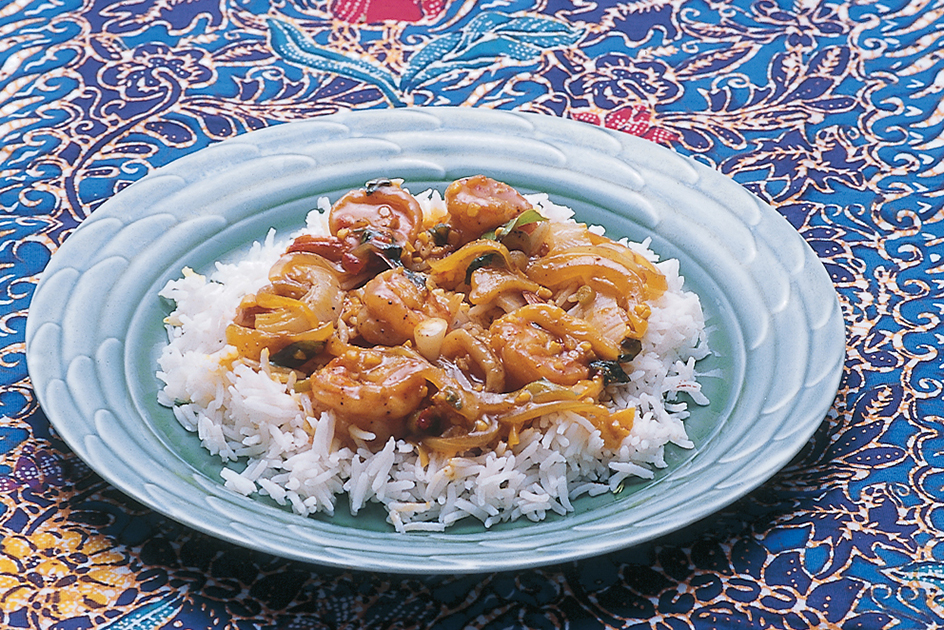
Rice is the staple dish of many people in Asia. Indians and many Southeast Asians serve rice with a wide variety curries. Japanese meals commonly include vegetables, tofu, and raw or cooked fish. Chinese cooking varies by region. For example, Cantonese cooks in southern China usually employ mild, subtle seasonings and sauces. On the other hand, Sichuan cuisine in south-central China is famous for its fiery pungent sauces. Rice is the staple grain in most of China. However, in northern China, people often serve meals with wheat noodles and buns, rather than rice. Australian food reflects the cuisines of both the continent’s British colonizers and more recent immigrant influences from Asian and Mediterranean countries.
The food industry
In less developed countries, many families grow their own food or buy food from local farmers. In developed countries, however, most people depend on the food industry. This section describes the food industry in the United States. Much of the information also applies to the food industries in Australia, Canada, Europe, and other developed areas.
The food industry consists of all the activities involved in producing food and getting it to consumers. These activities include (1) production, (2) processing, (3) packaging, (4) transportation, and (5) marketing.
The food industry is one of the largest industries in the United States. Workers in food-processing plants prepare and package foods for the market. Millions of other workers are involved in transporting, marketing, and serving food. Farmers form a small fraction of food industry workers—and many farmers rely on other jobs to support themselves.
Each activity in the food industry adds to the price of food. The prices thus reflect the cost not only of producing the basic food but also of processing, packaging, transporting, and marketing it.
Production.
The number of farms in the United States has declined from a high of almost 7 million in the 1930’s to around 2 million in the 2010’s. About 90 percent of these farms are small. But large farms supply most of the country’s food. Few farmers are needed to produce food because of the use of modern equipment and methods, such as commercial pesticides and fertilizers. The industrial efficiency of modern farms has enabled a small number of farmers to supply more than enough food to feed the country’s growing population.
Organic farming has also experienced huge growth in the 2000’s and 2010’s. Organic farmers do not use synthetic pesticides and fertilizers. They must feed their livestock organic food and cannot use artificial growth hormones. They must also refrain from giving antibiotics (medicines) to healthy animals. Organic food is often more expensive than conventional food. But demand for organic food is increasing, largely due to concerns about the environmental and health impacts of conventionally raised food.
Many modern farms specialize in raising one kind of crop or one kind of livestock. Most large U.S. farms that specialize in crops raise a field crop. Field crops require a fairly large amount of land to be raised profitably. The chief food field crops are corn, rice, soybeans, wheat, and sorghum, which is often used to feed animals. Field crops vary by region and by country. The United States, for example, produces more corn by far than any other country in the world.
Some farmers grow such foods as celery, green beans, lettuce, onions, or tomatoes. Others raise berries, grapes, nuts, or such tree fruits as apples, cherries, oranges, peaches, or pears.
Livestock farmers produce most of the nation’s meat, raising beef cattle, hogs, and poultry. Other livestock farmers keep dairy cattle or raise sheep. Some farmers raise goats or rabbits or bees for honey.
Today, more than half of the world’s annual fish harvest comes from aquaculture, or fish farms. A fish farm is an enclosure built on land or in natural bodies of water where fish are raised in large groups. Commercial fishing fleets also catch large quantities of wild fish and shellfish.
Processing.
Many of the foods in American grocery stores have been processed. Processing changes such raw farm products as grains and meat into other forms of food. For example, corn is processed into cornstarch, corn syrup, and corn oil. These ingredients are used in a wide variety of other grocery products, including soda, ketchup, and frozen meals.

Fresh eggs, fruits, and vegetables might only be washed and sorted before they reach the market. Otherwise, these foods may be dried or frozen. Fruits and vegetables also may be canned or pickled or used to make juice.
Meat packers slaughter cattle, hogs, and sheep. They then prepare the fresh meat for shipment to market. Meat packers also freeze, can, cure, and smoke meat, and they make it into sausages. Processors slaughter and prepare chickens, turkeys, and other poultry for market. Large amounts of fish and shellfish are cleaned and marketed fresh. In addition, processors freeze, can, or pickle certain kinds of fish and shellfish. Dairy plants pasteurize and homogenize milk. Pasteurization kills germs. Homogenization thoroughly blends in the milkfat that normally floats on top of the milk. Most dairies also add vitamins to milk. In addition, dairies—and companies that own dairies—make butter, cheese, ice cream, and yogurt from milk.
Other manufactured foods include convenience foods designed for quick, easy cooking or baking. Processors use cooked meats and vegetables in canned and dried soups, frozen dinners, and canned and frozen casseroles. They combine flour, sugar, dried eggs, and other foods in packaged dessert mixes.
Many processors add chemicals called additives to foods. Various kinds of additives may be used to improve or retain some quality of food, such as its color, flavor, nutritional value, or storage life.
Processing can make foods easier to consume. Such processes as pasteurization, canning, drying, and freezing help foods last longer by preserving them. However, highly processed foods often include extra sugars, fats, salts, and artificial chemicals, including additives. In addition, important nutrients can be lost in processing. Most unhealthful “junk food” is highly processed. Nutritionists advise people to eat diets with few highly processed foods and with many vegetables and fruits.
Packaging
is usually the last step in an industrial operation that processes food. In most cases, machines pack the food into containers. Packaging protects foods from being bruised or broken. Special packaging materials and methods can also protect foods from air, bacteria, insects, light, moisture, and odors—all of which can spoil food. Attractive packaging also helps promote the sale of foods.
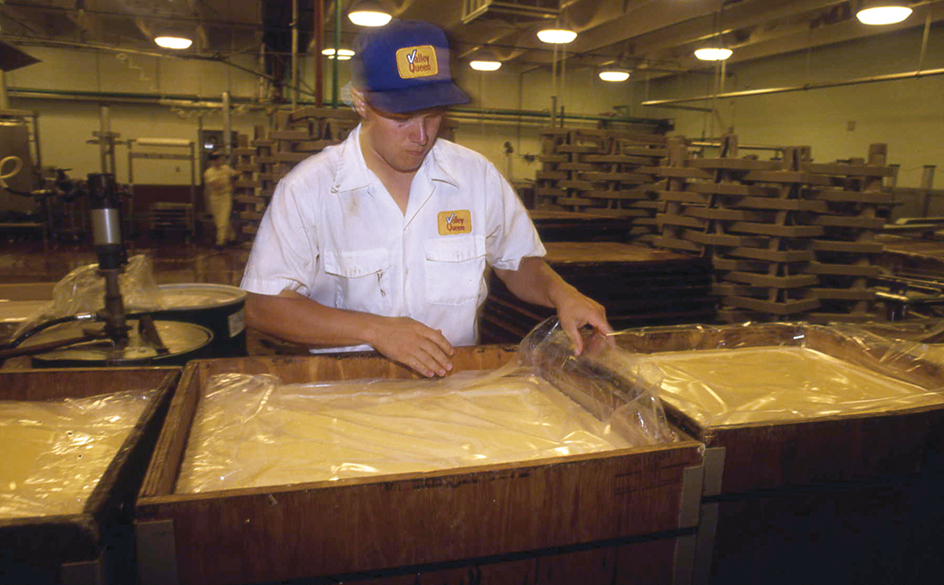
Packaging materials are useful in protecting and preserving foods, but they are also a source of waste and pollution. Some food companies have taken steps to reduce the amount of packaging in their products. Additionally, some grocery stores offer bulk food sections where consumers can scoop grains, dried beans, spices, and other foods into bags or into containers they bring from home. Bulk foods thus reduce packaging waste.
Transportation.
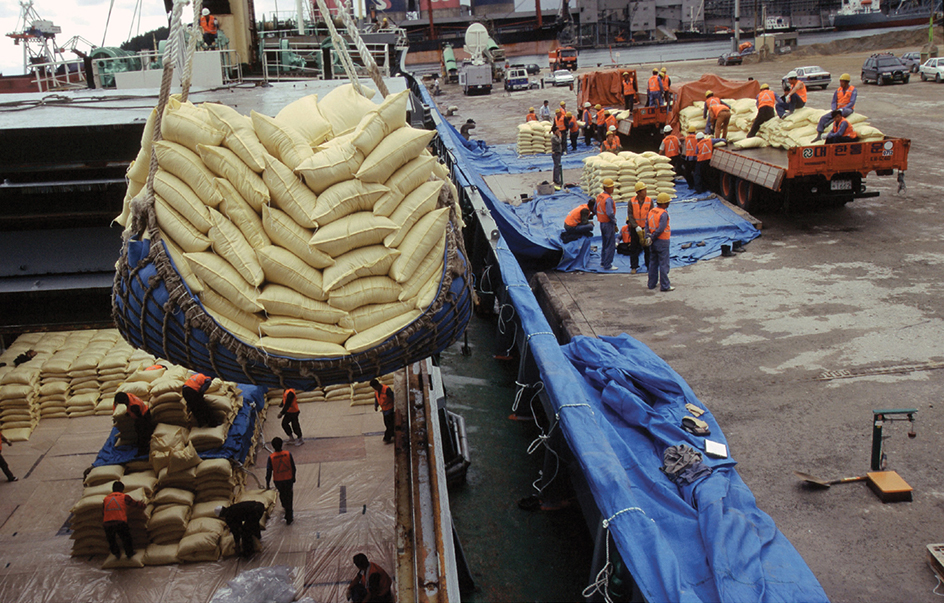
Commercial shipping companies transport most of the food from producers to processors and from processors to market. Almost all fresh foods must be shipped quickly before they spoil. Many vegetable farmers haul their produce to nearby markets soon after it is harvested. Over longer distances, refrigerated trucks, railroad cars, and ships help keep perishable produce fresh. Refrigerated vehicles also haul dairy products and frozen foods. In some cases, airplanes transport highly perishable or expensive foods, such as fish or live lobsters. Specially designed trucks and trains haul livestock.
Marketing.
Some farmers take their produce to a farmers’ market. At a farmers’ market, people can buy local food directly from the farmer who produced it. Interest in farmers’ markets has grown quickly in the United States, and thousands of farmers’ markets sell food around the country. Farmers’ markets often sell varieties of fruits and vegetables not available at conventional supermarkets. They may offer organic produce and animal products. Some restaurants purchase food from farmers’ markets.
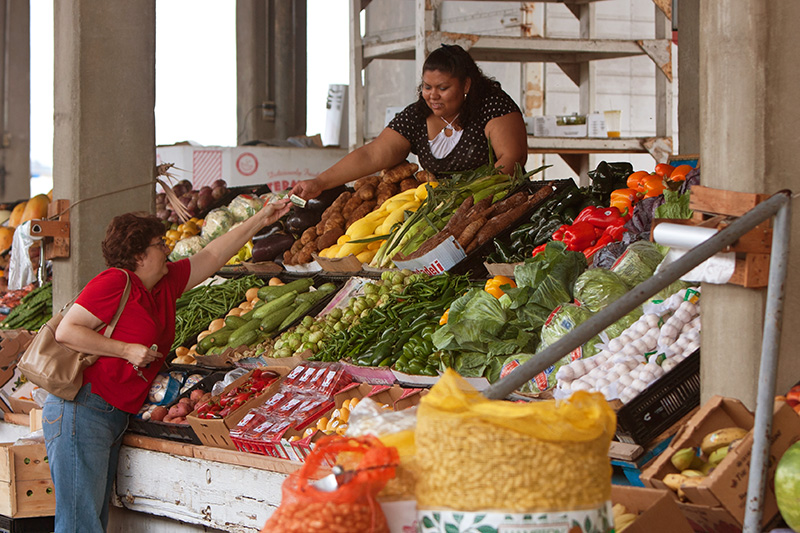
Many other farmers sell their products directly to a food processor. Other farmers belong to a marketing cooperative. A marketing cooperative tries to find the best markets for its members’ products so individual farmers do not have to search for buyers themselves. Some farmers sell their livestock to meat packers at large centers called terminal markets or at smaller auction markets.
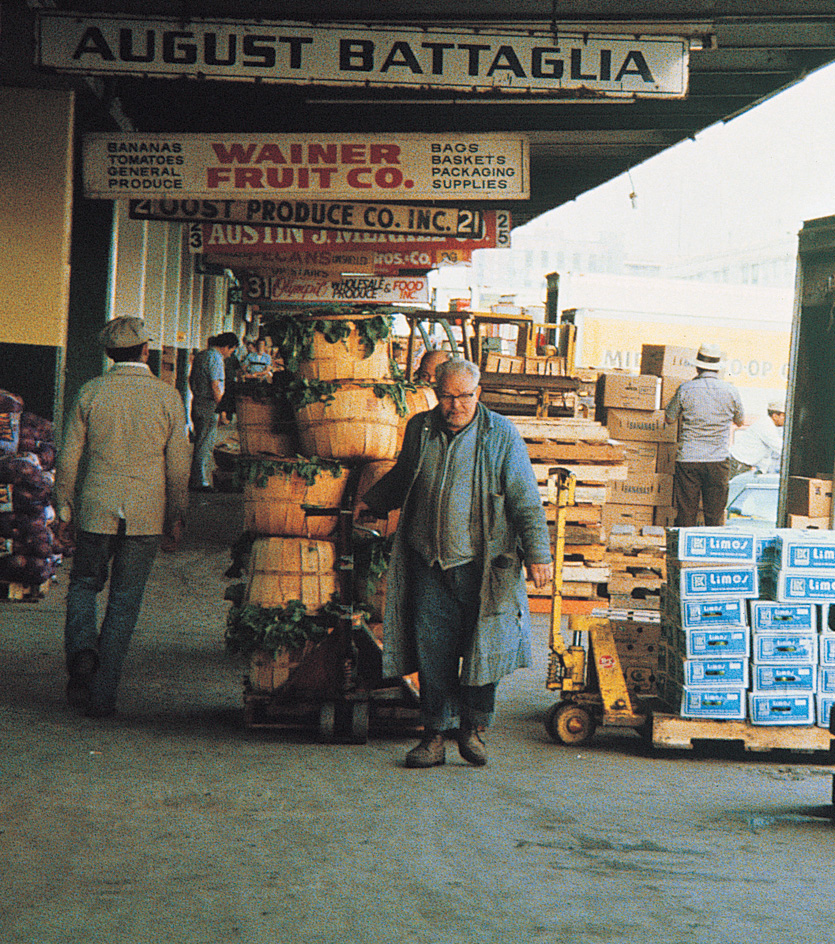
Many food-processing companies—and sometimes farmers themselves—sell their products to a wholesaler. Wholesalers buy large quantities of food and then sell smaller amounts to retailers. Food retailers include supermarkets, grocery stores, convenience stores, delicatessens, butcher shops, restaurants, and other businesses that sell food to consumers.

Government regulation.
In the United States, federal , state, and local government agencies supervise the food industry. These agencies aim to protect the health of consumers by ensuring the quality, cleanliness, and purity of foods. But in some cases, U.S. government agencies lack strong powers of enforcement and therefore must rely on the food industry’s cooperation in overseeing food safety. Federal and state laws regulate weights, measures, and container sizes to protect buyers from being cheated.
The U.S. Food and Drug Administration (FDA) suggests guidelines for the food industry in general and for the truthful labeling of most food products. The Department of Agriculture inspects and grades eggs, poultry, and red meat. The Department of Commerce supervises the production of seafood products. Regulations of the Federal Trade Commission (FTC) are the primary guard against false or misleading food advertisements. The Environmental Protection Agency (EPA) establishes acceptable levels for pesticide residue on plants grown for food or animal feed. Local health departments set standards of sanitation for dairy farms and dairy plants and for stores, restaurants, and other establishments that sell or serve food.
Other countries have similar agencies that regulate standards for their food industries. For example, the European Food Safety Authority is the major food regulator in the European Union. Food Standards Australia New Zealand sets standards and regulations for both Australia and New Zealand. In Canada, major food regulatory agencies include the Canadian Food Inspection Agency, Health Canada’s Food Directorate, and Agriculture and Agri-Feed Canada. The China Food and Drug Administration serves a role similar to the U.S. Food and Drug Administration.
Food research
is conducted by scientists working for food companies, food growers’ associations, food institutes, government agencies, research foundations, and universities. Their efforts have led to a tremendous increase in the quantity and variety of foods available.

Food research works to increase the food supply by developing more productive varieties of plants and live stock and more effective fertilizers and pesticides. In addition, some researchers seek ways to improve the flavor, appearance, or nutritional value of food products. Others study the effects of preservatives and packaging on the storage life of food. Researchers in food safety study the health risks to consumers from microbes, impurities, and additives in food.
Many food company researchers work to develop new food products. They seek ways to make the home preparation of processed foods easier. Dietitians and nutritionists look for methods to improve the human diet and to help people make better choices about the foods they eat. Agricultural economists study farm management and crop and livestock production.
History
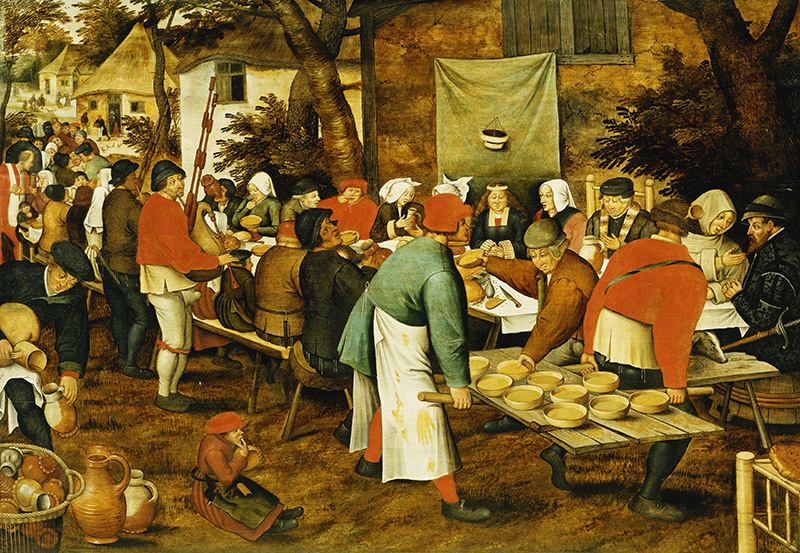
Tens of thousands of years ago, people lived by hunting and gathering, also known as foraging. They ate whatever foods they could find. Their diets relied heavily on plants, including wild fruits, greens, nuts, roots, and seeds. They caught fish and small land animals. In time, people developed better hunting weapons. They could then hunt large animals, such as bears, bison, deer, and wild cattle. If the food supply in an area ran out, they moved on.
After people discovered how to use fire, they could roast their food. After they learned how to make pots, they could also boil and stew food.
The development of agriculture.
By about 8000 B.C., people in several areas around the world had begun to raise plants and animals for food. The advent of farming assured people a steadier food supply. In many cases, however, agriculture also required more working time and left people vulnerable to crop failures. Grains were especially important crops. From grains, people developed such basic foods as bread and porridge. Farmers also raised cattle, goats, sheep, and other animals for meat and milk. By around 6000 to 5000 B.C., people in Asia and Europe were making cheese.
Some groups of prehistoric people were nomadic shepherds, also called pastoralists. These groups traveled across the countryside in well-established patterns, raising such animals as camels, goats, and sheep. Much of the nomads’ diet consisted of meat and milk from their livestock.
Civilization.
Between 3500 and 1500 B.C., the first great civilizations developed in river valleys. These valleys were the Nile Valley in Egypt, the Tigris–Euphrates Valley in what is now Iraq, the Indus Valley in what are now Pakistan and northwestern India, and the Huang He Valley in China. All these valleys had fertile soil and a favorable climate, enabling farmers to produce abundant yields. In ancient Egypt, for example, farmers along the Nile could raise two or three crops a year on the same fields. They grew barley, wheat, beans, lettuce, and peas. The Egyptians also raised such fruits as grapes and melons. Their livestock included cattle, goats, and sheep.
Ancient Greece and, later, ancient Rome could not produce enough food for their growing populations. As a result, they had to import large quantities of food from other countries. They also conquered and colonized lands that had plentiful food supplies. The Greeks and Romans thus enjoyed a variety of exotic fruits and spices from such areas as Persia, India, and China. Most importantly, though, they had a direct supply of wheat from Egypt. By the 200’s A.D., the Roman Empire covered much of Europe, most of the Middle East, and the Mediterranean coast of Africa. Many of the empire’s large farms specialized in raising wheat, which formed the basis of the Roman diet.
The Middle Ages.
After the Roman Empire split apart in the 400’s A.D., much of Europe was divided into large estates controlled by lords and worked by tenants. These estates generally provided the foods needed by the lords and the tenants. The foods included grains, beans, grapes and other fruits; such vegetables as cabbages and turnips; and poultry, cattle, and other livestock.

By the 700’s, Muslims had established a vast empire in the Middle East. The long reach of the Islamic Empire helped spread such foods as artichokes, lemons, oranges, and sugar to Europe. Between 1000 and 1300, thousands of Europeans went to the Middle East to fight in the Crusades. The crusaders acquired a taste for Middle Eastern spices and foods. After the crusaders returned to Europe, their desire for different foods—especially spices—helped to increase international trade. It also helped drive exploration of the oceans. Exploration in turn led to encounters among distant civilizations that would radically change what people ate around the world.
A global exchange of foods.
In 1492, the Italian navigator Christopher Columbus sailed west from Spain. He was seeking a short sea route to the spice-rich islands of what is now Indonesia. But Columbus landed in what became known as the New World of America, not the East Indies.
Although Columbus did not find the spices he sought, his voyage led to an exchange of many foods across the ocean. American Indians introduced Europeans to avocados, chocolate, corn, peanuts, peppers, potatoes, squashes, tomatoes, turkey, and vanilla, among many other foods. Corn became the most important crop of the European colonists who settled in the Americas. Meanwhile, Europeans and Africans introduced a variety of foods to the Americas, including apples, coffee, garlic, oats, okra, olives, onions, peas, rice, and tea. Settlers also brought with them such livestock as cattle, chickens, and hogs—animals never before seen by Native Americans.
During the 1500’s and 1600’s, European countries established colonies throughout the world. Many New World crops spread along new trade routes to assume key roles in Old World cuisines. For example, Spanish traders brought potatoes from South America to Europe around 1570. Potatoes eventually became a central ingredient in Irish, French, and German cooking. Portuguese and Spanish traders introduced chili peppers—originally from Central and South America—to southern Asia and parts of Africa. The use of spicy chilis became a hallmark of the foods of such countries as India, Thailand, Indonesia, and a number of regional Chinese cuisines.
Technological advancement.
As trade continued to expand, so did consumers’ ability to get foods raised far away. Advances in transportation and food preservation gave consumers in developed countries access to foods grown all over the world. These advances included such technologies as canning, which began in the early 1800’s, and mechanical refrigeration, which became widespread by the mid-1900’s. With automobiles, people could easily drive to restaurants or grocery stores miles away. By the 1950’s, many people in developed countries had kitchens with running water and ovens and stovetops, refrigerators and freezers, and other electric appliances—unimaginable luxuries for most of human history.
Many cuisines have long featured cheap, easily prepared handheld “street foods.” But fast food as an industry began in the United States during the 1920’s. Such restaurant chains as White Castle and McDonald’s applied standardized, industrial cooking and service techniques. By the 1980’s, American fast-food chains had spread throughout the world.
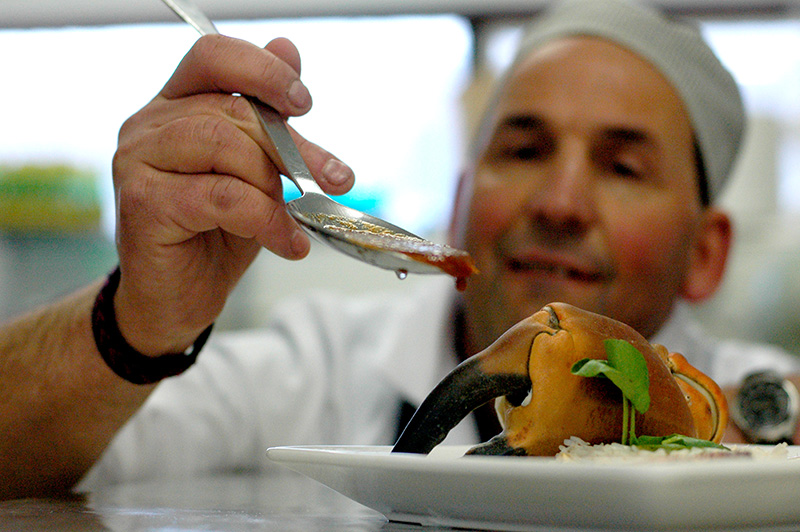
In the 2000’s and 2010’s, the world’s cuisines continued to change and influence one another. People in India, China, and other developing countries became wealthier, enabling them to eat American-style diets featuring many meats and processed foods. Meanwhile, new American fast-food chains featured burritos, sushi, kebabs, and other foods from around the world. Many fast-food restaurants began featuring healthier foods and natural ingredients. High-end chefs experimented with industrial cooking methods in a style known as molecular gastronomy.
Despite technological and farming advances, hunger remained a major problem around the world. In the 2010’s, nearly 1 billion people suffered from hunger and malnutrition.
